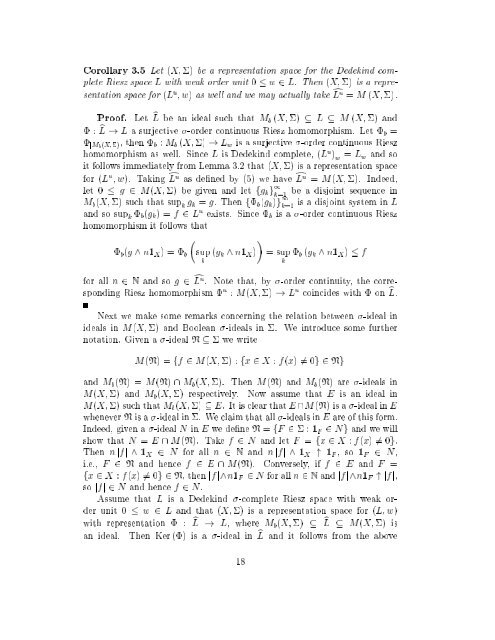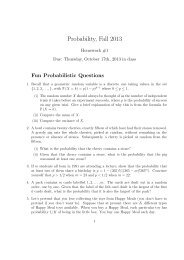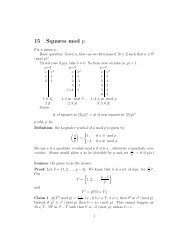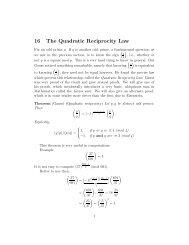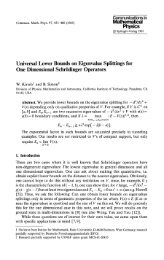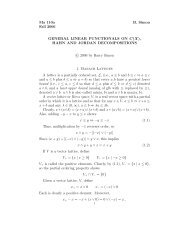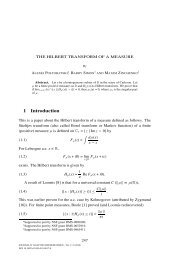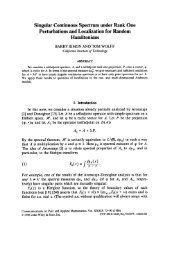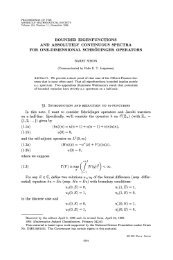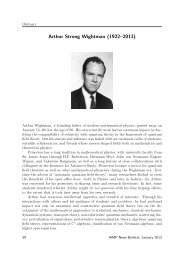Representations of positive projections 1 Introduction - Mathematics ...
Representations of positive projections 1 Introduction - Mathematics ...
Representations of positive projections 1 Introduction - Mathematics ...
You also want an ePaper? Increase the reach of your titles
YUMPU automatically turns print PDFs into web optimized ePapers that Google loves.
Corollary 3.5 Let (X ) be a representation space for the Dedekind complete<br />
Riesz space L with weak order unit 0 w 2 L. Then (X ) is a representation<br />
space for (L u w) as well and we may actually take cL u = M (X ).<br />
Pro<strong>of</strong>. Let b L be an ideal such that Mb (X ) L M (X ) and<br />
: bL ! L a surjective -order continuous Riesz homomorphism. Let b =<br />
jMb(X ), then b : Mb (X ) ! Lw is a surjective -order continuous Riesz<br />
homomorphism as well. Since L is Dedekind complete, (L u ) w = Lw and so<br />
it follows immediately from Lemma 3.2 that (X ) is a representation space<br />
for (L u w). Taking cL u as de ned by (5) we have cL u = M(X ). Indeed,<br />
let 0 g 2 M(X ) be given and let fgkg 1<br />
be a disjoint sequence in<br />
k=1<br />
Mb(X ) such that supk gk = g. Then f b(gk)g 1<br />
is a disjoint system in L<br />
k=1<br />
and so supk b(gk) = f 2 Lu exists. Since b is a -order continuous Riesz<br />
homomorphism it follows that<br />
b(g ^ n1X) = b sup (gk ^ n1X) =sup<br />
k<br />
k<br />
b (gk ^ n1X) f<br />
for all n 2 N and so g 2 cL u . Note that, by -order continuity, the corresponding<br />
Riesz homomorphism u : M(X ) ! L u coincides with on bL.<br />
Next we make some remarks concerning the relation between -ideal in<br />
ideals in M(X ) and Boolean -ideals in . We introduce some further<br />
notation. Given a -ideal N we write<br />
M(N) =ff 2 M(X ) : fx 2 X : f(x) 6= 0g2Ng<br />
and Mb(N) = M(N) \ Mb(X ). Then M(N) and Mb(N) are -ideals in<br />
M(X ) and Mb(X ) respectively. Now assume that E is an ideal in<br />
M(X ) such thatMb(X ) E. It is clear that E \M(N) isa -ideal in E<br />
whenever N is a -ideal in . We claim that all -ideals in E are <strong>of</strong> this form.<br />
Indeed, given a -ideal N in E we de ne N = fF 2 :1F 2 Ng and we will<br />
show that N = E \ M(N). Take f 2 N and let F = fx 2 X : f(x) 6= 0g.<br />
Then n jfj ^1X 2 N for all n 2 N and n jfj ^ 1X " 1F , so 1F 2 N,<br />
i.e., F 2 N and hence f 2 E \ M(N). Conversely, if f 2 E and F =<br />
fx 2 X : f(x) 6= 0g2N, then jfj^n1F 2 N for all n 2 N and jfj^n1F "jfj,<br />
so jfj 2N and hence f 2 N.<br />
Assume that L is a Dedekind -complete Riesz space with weak order<br />
unit 0 w 2 L and that (X ) is a representation space for (L w)<br />
with representation : bL ! L, where Mb(X ) bL M(X ) is<br />
an ideal. Then Ker ( ) is a -ideal in bL and it follows from the above<br />
18


